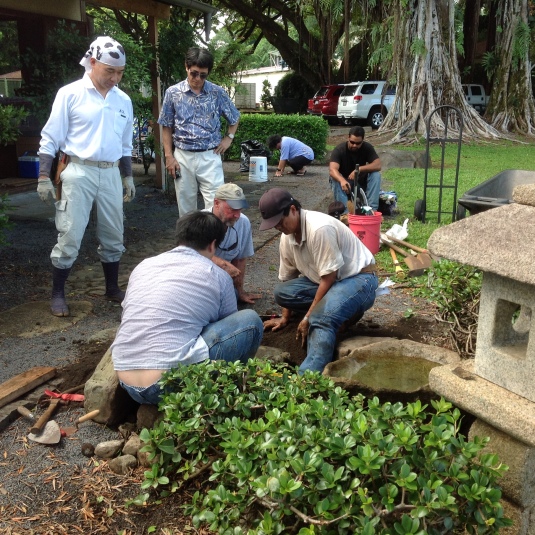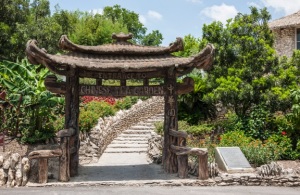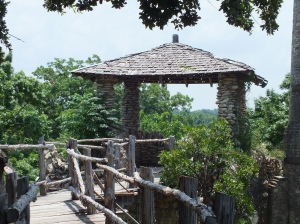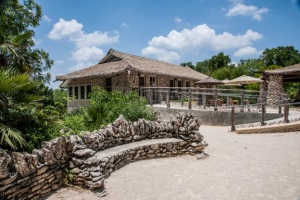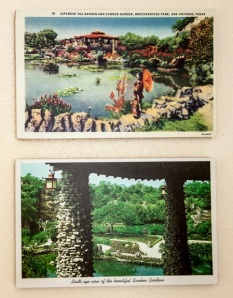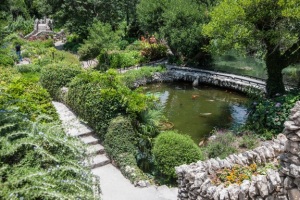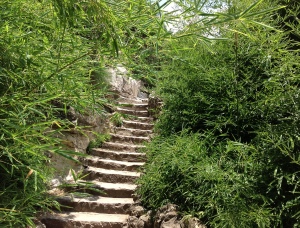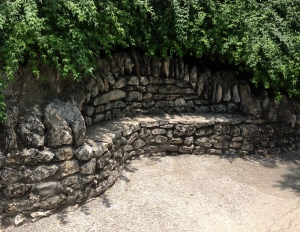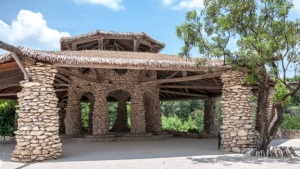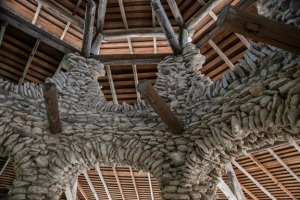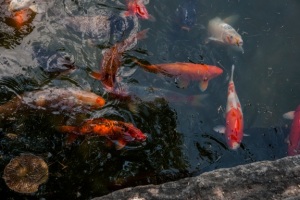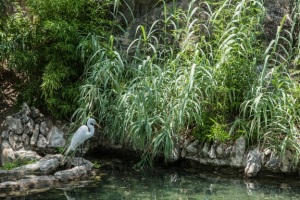
(photo by Bill F. Eger)
After obtaining his degree in horticulture in Japan and interning at the Chicago Botanic Garden, Akiyoshi (Ebi) Kondo joined Denver Botanic Gardens as a Horticulturist in April 2000 and was in charge of the display gardens and collections.
In 2003 Ebi was promoted to Senior Horticulturist and took responsibility of Sho-Fu-En, Denver Botanic Garden’s Japanese Garden. Originally designed by Koichi Kawana, construction on the two acre garden began in August 1978. Sho-fu-en, Garden of the Pines and Wind, was dedicated June 23, 1979.
“This was designed to be a provincial garden. Gifu-ken and Takayama-shi are next to the Nagano mountains, a very rugged area. Here we are amid the Rocky Mountains, also a rugged area,” Kondo said.

A simple clean pond edge, a clear reflection, careful maintenance, the contributions of garden designers and gardeners since 1978 all add up to the shibui feeling of Sho-fu-en.
(photo by Bill F. Eger)
“This was one of Kawana-san’s last major gardens. It’s very shibui, very quiet.”
Koichi Kawana designed gardens in St. Louis, Missouri; Chicago, Illinois; Memphis Tennessee; Los Angeles and San Diego, California among others. The Hokkaido native who became a U.S. citizen in 1971 died in 1990 at the age of 60.

Garden designer Koichi Kawana
(photo from City of Los Angeles Department of Public Works)
In 1979, the tea house was constructed in Japan “very mountain style,” said Kondo. “Not an ostentatious display; very good size for demonstrating tea ceremony.”

Ebi Kondo holds open the gate to the 1979 tea house at Sho-fu-en.
Built by Kumo Construction Company in Nagano, the tea house was disassembled and shipped to Denver. Company president Mr. Toshitame Hirabayashi and eight co-workers reassembled the teahouse along with the bridge and entry gate in 14 days. The teahouse was donated by the Eleanore Mullen Weckbaugh Foundation.

tea house interior with chairs set up for demonstration audience to the right
When the garden started, more than 130 character pines were moved from nearby Estes Park by the Rocky Mountain Bonsai Club. Permits were obtained from the U.S. Forest Service to collect Ponderosa pines. “Japanese gardens encourage the use of native plants. We have about 50 percent natives in this garden,” Kondo said.

Bob Kataoka and Kai Kawahara inspect pines near Denver for possible inclusion in the garden.
(photo from Rocky Mountain Bonsai Club history)
In 1977, Bob Kataoka, Kai Kawahara, Harold Sasaki, Floyd Sunshine, Bob Krueger, Keith Jepson, Larry Jackel and Malcolm Correll manned the first flatbed truck collecting eight or ten pines that trip. Kai Kawahara, was a gardener at Sho-fu-en from 1980 to 1993. He was one of eight founding members of the earlier Denver Bonsai Club that merged to form RMBC.

Head gardener Kai Kawahara in Sho-fu-en in 1987
(Denver Post photo archive)
As sometimes happens in the history of Japanese gardens in America, there came a period of disinterest, low funding and lack of maintenance. By 2000, the garden was in disrepair. “A garden without maintenance for even one season may take ten seasons to reclaim,” Kondo said.
He undertook the initiative of the garden’s restoration reaching out to Mr. Seki the Consulate General of Japan in Denver and ultimately partnering with Mr. Sadafumi Uchiyama from Portland Japanese Garden.

Sadafumi Uchiyama at a NAJGA regional meeting in Chicago, September 2011
Sadafumi Uchiyama created a master plan for the development of Sho-fu-en in 2003. Phase one included a minor repair of the Tea Ceremony House/garden path ways and phase two encompassed restoration/ renovation of the existing lake and was completed over the following years.

Some lanterns are designed for display near water.
(photo by Bill F. Eger)
In 2007 with help from the Hosokawa Grant, Kondo founded Denver Botanic Gardens tea ceremony guild Sho-Fu-Kai. The guild’s mission is to expose the public and garden patrons to Japanese Tea Ceremony and support the Sho-fu-en. A new machiai, rojimon (gate), obote senko design, uchi roji (inner path), and soto roji (outerpath), were added to the tea garden, opening to the public in mid-June this year.

Sadafumi Uchiyama arranged for the new well at the tea garden to be shipped from Portland, Oregon.
(photo by Bill F. Eger)



Now, Sho-fu-en is one of a few signature gardens at Denver Botanic Garden.”We work hard to keep our volunteers happy and enthusiastic,” Kondo said. “We have monthly cultural nights, and regularly scheduled nature hikes and movie nights.
“We need to continue developing and implementing a program, a vision for our garden,” Kondo said. “Otherwise, it is an ornament, not a garden.”
Future programs in development at Sho-fu-en include the Horticultural Therapy Program and Volunteer Docent Program.
Kondo and Uchiyama are among the leadership members of the North American Japanese Garden Association (NAJGA), an organization newly formed for the purpose of networking public Japanese Gardens in North America. Kondo also is a member of the Japan America Society of Denver.
NAJGA holds its Connections conference in Denver this weekend (October 2012) with a full slate of workshops at the Denver Botanic Gardens. Also on the program is the premiere of David Slawson’s new film “Evoking Native Landscape Using Japanese Garden Principles” at the Sheraton Downtown on Friday evening. For further information, contact NAJGA at http://www.najga.org
Please feel free to comment on your experience with Denver Botanic Gardens and Sho-fu-en in the comment box below.
Other exhibits at Denver Botanic Gardens:
In addition to the Japanese garden, there are displays in other parts of the botanic garden grounds.

The bonsai club continues to hold juried shows and sales at Denver Botanic Gardens. This one was held Father’s Day weekend 2012.
Kizuna — West Meets East, a series of site specific bamboo installations by Tetsunori Kawana from Japan and Stephen Talasnik from America, continues through November 4.


close up of work by Tetsunori Kawana
Also in mid-June 2012, a bonsai pavilion and courtyard opened as a memorial to the late news writer Bill Hosokawa. It was funding from the Alice and Bill Hosokawa Fellowship that helped Sho-fu-kai, the tea ceremony guild, form in 2008.

the new bonsai pavilion shortly before it opened to the public June 2012

The Bill Hosokawa Bonsai Courtyard after a rain storm, Saturday, Oct. 13, 2012.
To view a full size image of any photo, just click on it. Photographs not otherwise credited in this blog are by K.T. Cannon-Eger.
For more information on bonsai history and World War II internment camps, please see
http://www.magiminiland.org/BigPicture/Internment.html
For more information on Denver Botanic Gardens, please visit
http://www.botanicgardens.org/
[updated 8/6/2016 with new website for bonsai history and World War II internment camps]
Save









